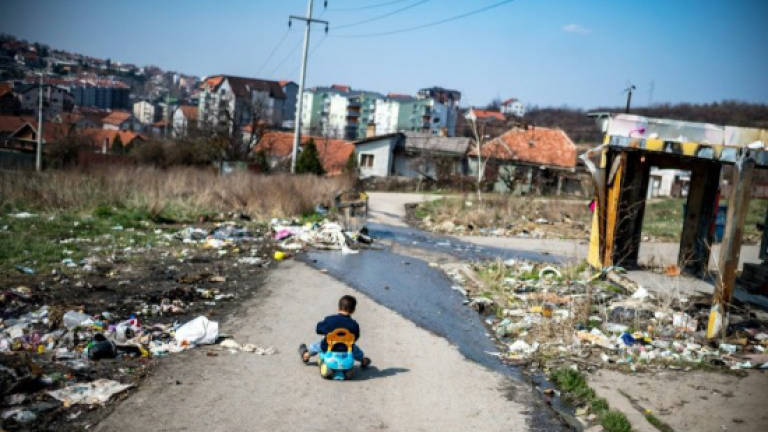For Serbia's Roma, just getting a roof over their heads is a start

BELGRADE: Bekim Gashi and Kasandra Cac are neighbours in Orlovsko Naselje, a Roma area in Belgrade. But while one dreams of his daughter becoming a doctor, the other sees "no future" for hers.
Their worlds are only a few dozen metres apart but are completely different.
Gashi, 32, managed to obtain social housing for his family after being selected from a list, while on the hill just above it, 20-year-old Cac survives in a substandard camp.
Although their lives have arbitrarily taken different paths, they are among thousands of Roma in Serbia, as in the rest of the Balkans, to be "exposed to discrimination in almost all areas of life", according to a 2016 European Commission report on the country.
From lodging and education, to access to employment and health, Roma in Serbia face inequity.
Raising awareness of such issues is one of the aims of International Roma Day on Sunday, an event which annually also seeks to celebrate Roma culture.
Serbia's Roma community officially numbers 150,000. But rights groups and the Council of Europe estimate the actual number to be three to four times higher.
EU funds
After years spent in one of Serbia's 500 to 600 makeshift camps, Gashi and his family now live in a 60m² apartment in a municipality building.
It was constructed in 2015 with the help of European Union funds.
The EU scheme was drawn up to help 170 families, of which 12 live in Gashi's building.
He was one of the lucky ones, plucked from the Jabucki Rit camp in the suburbs of the capital, Belgrade.
But there is little housing available to meet the needs of Serbia's Roma community.
'I cannot study'
Cac lives in one of about 20 containers looking over the building, surrounded by rubbish and without running water.
She is expecting her second child.
"It's not possible to live here," she told AFP.
Cac, her daughter, husband and four other family members survive on some 100 euros (RM474) of social benefits a month.
After an icy winter, Cac is anxious about the Balkans summer when it will become difficult to breathe in her metal container.
The camp was supposed to be a temporary solution when it was installed a decade ago.
Drug addicts set fire to the sanitary building, residents said. And the few portable toilets that were put in are now in an appalling state.
During school hours, many children can be seen playing amongst the containers.
"I would like to finish high school, but I cannot study here," said Daniela Markovic, 17.
Only a handful have gone as far in their studies.
According to Ljuan Koka, of the Belgrade-based Centre for Education of Roma and Ethnic Communities (CEREZ), only 15% of Roma complete primary school, meaning at the age of 15, compared with 93% of all Serbian pupils.
And just seven to eight percent of Roma children go on to high school.
In her flat, Gordana Gashi, 10, has a computer, provided by city authorities to families living in the building with children attending school.
After class a "friend comes to my house to learn together", she said.
When she lived in Jabucki Rit camp, she often missed school.
"We lived in the mud, in a house made up of boards and plastic," said her father, Bekim, who earns a small wage from the municipal authority helping Roma with administrative matters and mediating on problems in the building.
Prejudice and mockery
His children would be "clean when they came out of the shack and covered with mud when they left the slum" meaning they would feel "too uncomfortable" to go to school, he recalled.
But now they are "looked at like the others" at school and no longer stand out, he said.
In front of her container Kasandra's mother-in-law, Tatjana Cac, 41, tells a different story of persistent "prejudice".
"Some laugh on seeing our children, make fun of their clothes, our lack of education," she said.
In 2016, the United Nations estimated that in Serbia "90% of children in Roma settlements are growing up in poverty".
"The infant and under-five mortality rate is two times higher than that of the general population, 15% of Roma children are born with low birth weights, one-fifth is malnourished and only 13% are fully immunised," the UN said in a statement.
Rivalry between Roma
"There are fights all the time ... Neighbours do not like us and I understand them," sighed another camp resident Marijan Filipanovic.
"Why do they have a home and not us?" the 41-year-old man said, pointing to the building below.
For Koka, the relocation programme, which provokes "rivalries and conflicts" between Roma, is like putting a plaster on a wooden leg.
It will not break the "vicious circle of poverty", he argued.
Even if city authorities were to foot half of the most urgent costs for the worst-off Roma, "who pays the other half?" Koka asked.
He said a recycling centre had been planned for Orlovsko Naselje which would have provided jobs for the Roma but it never saw the light of day, despite subsidies. — AFP